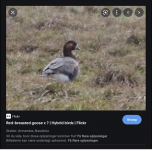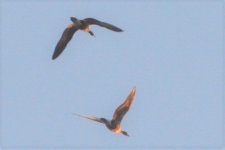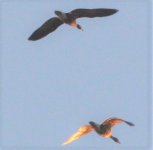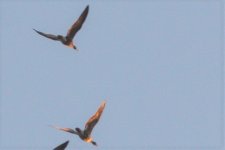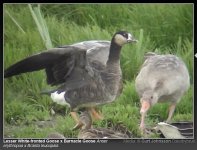troelseskeortvad
Member
Presumed hybrid Red-breasted Goose x Greater White-fronted Goose in the Western Baltic Sea, Oct. 29, 2021.
On a bird survey in the Baltic Sea off Bornholm, Denmark, we observed a goose on SW migration that we presume to be a Red-breasted Goose x Greater White-fronted Goose hybrid.
It passed out boat at less than 100m distance in a flock of white-fronts. We got some photos, but from the back only. As can be seen, it had a uniform dark brown plumage, lacking black areas, short thick neck and head and short bill. On the side of the head/neck it showed a pale ring, very much reminiscent of Red-breasted Goose, not showing well on the photos, unfortunately. We are not sure, if it showed pale at base of bill, which the photos indicate. It was only slightly smaller than the Greater White-fronts, thus quite a lot bigger than Red-breasted Goose.
On the collage, the top and bottom goose is a Greater White-fronted.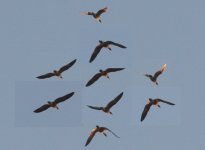
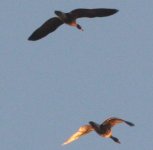
Comment very much appreciated
In case a similar-looking goose is found, or have been observed somewhere else, I will be very pleased to know too..
Cheers
Troels
On a bird survey in the Baltic Sea off Bornholm, Denmark, we observed a goose on SW migration that we presume to be a Red-breasted Goose x Greater White-fronted Goose hybrid.
It passed out boat at less than 100m distance in a flock of white-fronts. We got some photos, but from the back only. As can be seen, it had a uniform dark brown plumage, lacking black areas, short thick neck and head and short bill. On the side of the head/neck it showed a pale ring, very much reminiscent of Red-breasted Goose, not showing well on the photos, unfortunately. We are not sure, if it showed pale at base of bill, which the photos indicate. It was only slightly smaller than the Greater White-fronts, thus quite a lot bigger than Red-breasted Goose.
On the collage, the top and bottom goose is a Greater White-fronted.


Comment very much appreciated
In case a similar-looking goose is found, or have been observed somewhere else, I will be very pleased to know too..
Cheers
Troels




